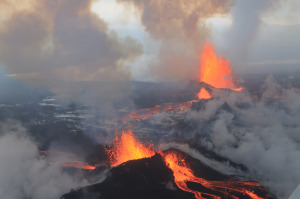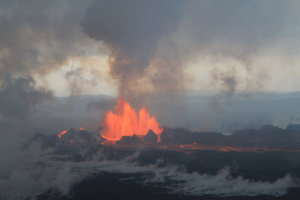Icelandic volcano eruption: Latest news
Bárðarbunga is the volcano in Iceland that everyone is watching at the moment. It is the second highest mountain in Iceland and it began erupting spectacularly on the 23rd of August 2014 and continues to spew lava at a rate of around three hundred and fifty cubic meters per second nearly two months later.
Is it the beginning of the end?
As of the 22nd of October, geologists report a reduction in lava flow and a reduced frequency in earth tremors and the generally accepted theory is that the eruption might be coming to an end. There is certainly less surface activity: fewer plumes of lava and a reduction in magma emitting from the volcano. Certain experts differ and hold the belief that Bárðarbunga may erupt again at any time.
The caldera continues to sink, but at a slightly reduced rate since the initial phases of the eruption when it subsided by about 50 cm per day. Since mid-October, the estimated subsidence of the caldera has reduced to around 40 cm per day. This subsidence is caused by release of magma from the magma chamber within the volcano. As the magma flows out of the volcano, there is less molten rock to support the caldera.
At present, the lava flow field is more than 61 square kilometres in area and expanding. At the same time, a huge lake of lava has formed around the Holuhraun fissure. Fountains of lava are less frequent than they previously were, but vast amounts of sulphur dioxide are being released from the eruption site and lava lake. These emissions can be dangerous to human health and the met office in Iceland is monitoring pollution in the area.
What about quakes?
There is certainly plenty of on-going earthquake activity. Quakes of 3 to 4.9 magnitudes are still measured as occurring at a one to three hour frequency with quakes of a magnitude greater than occurring every twenty to thirty hours. However, it should be borne in mind that the most intense quake measured during October was ‘only’ 5.4. For a number of weeks, these statistics have remained the same. When represented graphically, the graph has a stable, flat line that many interpret as the volcano reaching a point of equilibrium that will signal quieter times ahead, but many believe that the fireworks are far from over.
Related pyrotechnics
There are concerns regarding a possible glacier – outburst floods in the river Jökulsá á Fjöllum causing a massive displacement of water measuring up to twenty five thousand cubic meters of water which would reach the Holuhran lava field in as little as half an hour. This can have some consequences for the area around Bárðabunga.
Driving in Iceland: how are we affected?
Driving in Iceland has taken on a new edge, but authorities believe that the Route 1 Ring Road is now safe enough to remain open although access roads closer to the volcano remain closed to all but scientific personnel for safety reasons. A word of caution: Sulphur dioxide pollution occurs variably depending on wind direction and wind speed, so it would be wise to check with the met office regarding any pollution updates before committing yourself to the ring road in the vicinity of Bárðarbunga.
The Route 1 ring road is one of the most spectacular drives in the world and remains a popular attraction despite Bárðarbunga’s ongoing eruption. In fact, people seem to be eager to get as close as the can to Bárðarbunga. The Route 1 ring road remains at a ‘safe’ distance and although it was an exciting route before, now has an extra element of adventure owing to Bárðarbunga.

